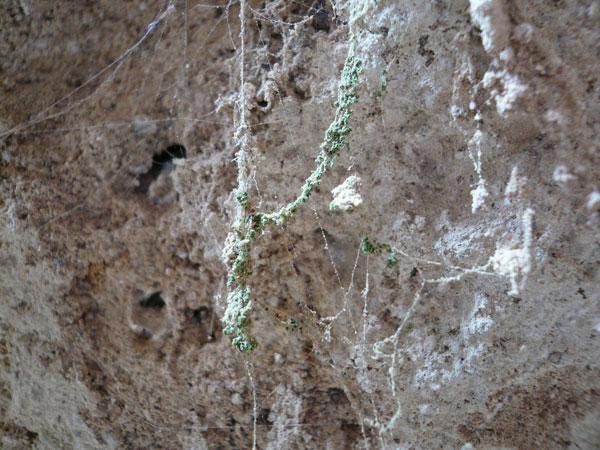
Extreme Microbe Drinks Dew on Spiderwebs to Live

In the bone-dry desert, a truly remarkable, newfound microbial species manages to eke out a living drinking the meager moisture that condenses from the air onto spiderwebs.
The extremophile species – so-called because it can survive in an extreme, harsh environment where most life would wither – was discovered recently in a cave in the Atacama Desert in Chile.
This spot is so dry, the only water vapor in the air comes from a fog that rolls in from the distant coast overnight. Some of this moisture condenses on spiderweb silk in the form of dew. This dew, scientists think, keeps the microbes alive.
The new species is a type of green unicellular alga called Dunaliella. Since all previously known species in this genus were found in extremely salty aquatic environments, the researchers were surprised to find them living in the Atacama, the driest place on Earth, said microbiologist Armando Azua-Bustos of the Pontificia Universidad Catolica de Chile. Azua-Bustos led the project that found the amazing microbe.
"We were trying to understand what kind of microbial life you would find where there is almost no water at all," Azua-Bustos told OurAmazingPlanet. "The humidity of the air there drops to zero at certain parts of the day."
The scientists decided to look for life in caves in the desert, which seem to provide a partially protected environment, sheltered from the harsh heat and blaring ultraviolet rays of the sun. They detected the Dunaliella algae growing only on spiderwebs that clung to the cave walls.
To test whether enough moisture could reach the microbes through condensation, the researchers placed humidity sensors in the cave. Sure enough, they found that a fog would come in the cave during the night, and in the morning dew would condense on the webs.
Sign up for the Live Science daily newsletter now
Get the world’s most fascinating discoveries delivered straight to your inbox.
"You could see the little drops of water on the spider webs," Azua-Bustos said.
The environment in the Atacama Desert, in fact, is a good analogue for Mars because of the intense radiation it receives and the very dry conditions, Azua-Bustos said. Finding life here suggests there may be hope for life on the Red Planet also.
The discovery is detailed in a recent issue of the journal Extremophiles.
- The Harshest Environments on Earth
- Video: Extremophile Hunter Searches for 'Impossible' Life
- Top 10 Greatest Mysteries in Science
Clara Moskowitz is a Senior Writer for LiveScience, a sister site of OurAmazingPlanet.
This article was provided by OurAmazingPlanet, a sister site of LiveScience.
Most Popular

